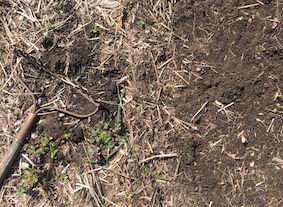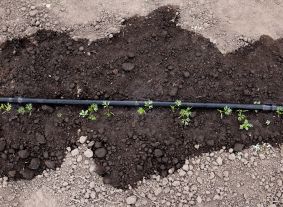Garden Rake a Workhorse in the Garden
Views: 1059

The garden rake is my new favorite tool in the garden. I’ve written a bunch about good vegetable garden tools before, such as THIS and THIS , which I still hold in high esteem in the hand tool category. But, the garden rake, that’s a vegetable garden tool with heft. Plus, it has multiple purposes that can be used all season long.
What Is a Garden Rake?
The root English (raca) /Dutch (raak) /German (Rechen) word for rake means to scrape together or to heap up, which is a great partial description of what a garden rake can do. A full-sized garden rake is a long-handled instrument affixed with a steel bar from which emerges 2- to 3-inch-long heavy duty tines. It differs from a leaf or thatch rake in that the latter rakes have a fan of long (foot long or more) thin plastic or steel tines one end. Like any tool, the size and durability and intended use differs by brand. One garden rake I’ve seen recently (and have coveted ever since) has two sets of tines—one more traditional and another a bit shorter and closer together—on the opposite side. It reminds me of the old-school pocket combs with thicker- and thinner-space tines for how delicate you want to be to slick back your pompadour.
What Garden Rakes Can Do
Here’s a brief list of what the garden rake has done for me:
Bed clearing. The photo above shows what I did with a garden rake on my first day in my community garden plot this season. It looked like an hours-long weeding project in a straw-covered plot. However, it became a half-hour of medium-vigor raking with the long steel tines of the rake. One long pull of the rake pulled off the mulch to reveal the ground and the weeds beneath. Subsequent backs and forths with the rake easily loosened most of the weeds. More secure weeds were few, and I could use a small hand tool to dig them out.
Bed smoothing. Then, with the weeds and mulch out of the way I could use the garden rake to smooth the soil surface, moving rocks out of the way.
Clump breaking. Hold the rake vertically with the tines parallel to the ground. Use that to pound and break up dirt clumps.
Pushing. Hold the garden rake at a 45-degree angle to the ground. Then, keep the tines pointing up and push soil or debris into piles. That’s how I gathered up all the straw mulch.
Lines. Drag the top of the handle across the soil to mark rows for seeds.
Tamping. Use just as described in “clump breaking” above to tamp down the soil after sowing seeds. Then, tamp the ground a bit harder to create a harder soil surface, maybe one you want to create a path.
Measuring. The width of the garden rake head is a good distance between rows of seeds. And if that’s the space between your rows, then you’ll know you can easily get in there and rake up any emerging weeds throughout the season.
Meet Ellen Wells
When you’re raised on a farm, you can’t help but know a thing or two about gardening. Ellen Wells is our expert on edible gardening.…
Ellen's Recent Posts

Asparagus






